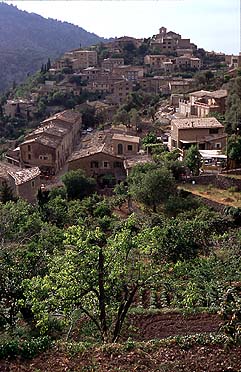
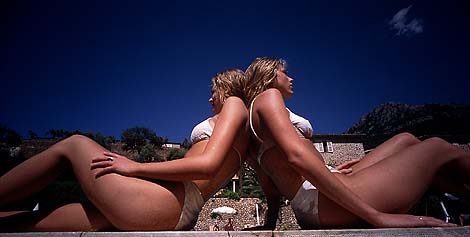
I only wanted to go there to borrow the 16mm Hologon - and I never expected the flower of Teutonic teenage beauty to have been shipped to the center of the Med with it..
The photographic press occasionally has the chance to browse as a large herd instead of indulging in solitary hunting for information; at the end of April, Carl Zeiss and Kyocera Corporation afforded such an opportunity by inviting a handful of editors from each European country to a technical symposium.
This was a one of the best-organised such events I have attended; by isolating the group comfortably in the Mallorcan mountain resort of Deia, the usual wandering off to find all-night disco bars was eliminated. The different country�s groups really mixed, in sharp contrast to Kodak's Panther film launch in Vienna where many national Kodak presences ensured the usual linguistic huddles. This event wasn't even attended by any British Contax staff. Wolf, Zeiss's head of PR, actually lives on Mallorca and works from there. Lucky guy. Maybe if Photon on WWW starts earning me a living... after all, it doesn't really matter where you live in the age of Internet!

The village of Deia, where the poet Robert Graves lies in the hilltop cemetery, seen thru the Contax 90mm Sonnar. I visited the cemetery. It had a big notice about showing respect on the gate, so I hesitated to enter with my camera. Then I heard laughter and sort of crunching noises. Three French girls were eating their lunch and drinking beer, sitting between the graves. The notice was not in French.
The content of the symposium papers and discussions was very serious. On the surface, the event seemed to be about explaining why the Contax G1 works in the way it does, saying why many test reports contained errors of interpretation, and providing 16mm Hologon ultra-wide lenses for test. This, together with a history of Zeiss lenses and a chance to learn about and try out some very serious binoculars, formed the main program.
There was, however, a hidden agenda. Zeiss made a substantial paper loss last year, most of it incurred through taking over the East German CZ Jena plant with its legacy of twenty thousand employees. The German press visitors were clearly more concerned with the future of Zeiss than the rest of us; the symposium openly asserted the health and optimism of Zeiss. The recent takeover of Rollei by Korean giant Samsung has given Germans cause for deep thought; Zeiss is an even brighter jewel in the crown of German industry, and the symposium was a show of strength at a time when few others have the funds to take you out to lunch, let alone maroon half the Euro press in the mountains of Majorca.
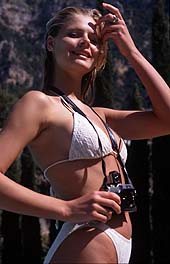
The Contax with a Hologon fitted is a very slim camera - you can wear it under your shirt and no-one would know it was there. If you are wearing a shirt, that is. Shot on the G1 with 90mm.
Part two of the hidden agenda concerned the Zeiss-Kyocera relationship. Contax equipment, including lenses, is manufactured by Kyocera Optec in Japan (a country where very little 'Japanese' camera output is actually manufactured these days). Japan has suffered some serious exchange-rate problems, while Zeiss in Germany has acquired a substantial Eastern facility with a combination of experience, potentially low costs and a great emotional attachment.
The symposium was a conspicuous confirmation that Zeiss and Kyocera would continue to produce Contax equipment just as it has been produced over the last twenty years. Unspecified products are scheduled for the Jena and Dresden CZ plants; binocular manufacture is passing to a Wetzlar-based subsidiary. Contax cameras, and Contax Zeiss lenses, are staying in Japan.
This, in turn, implies a maintenance of the existing relatively high prices and retro specifications. We were invited to make our comments from the floor on the future and directions of photography; after many short dialogues and exchanges, it seemed to be concluded that serious enthusiast photography would survive but enjoy a market much smaller than was once the case. The dramatic fall in SLR sales and the takeover by the 35mm compact was pointed to.
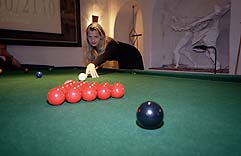
The German models, who were 16-year-old winners of a 'supermodel' contest, were asked to be around the bar in the evening so we could test flash. They turned up in jeans and looked fine. One of them wanted a game of snooker. So our German hosts immediately sent them both to get changed into short black dresses; ideal for those middle-of-the-table shots, eh? Then no-one bothered to take any pictures, except me because I had a big Contax SLR system flash stuck on the G1 with a 28mm lens. I took a couple of shots. The girls declined to play snooker (they were hardly dressed for it) and the press listened to the guitar trio. It turned out we all play guitar, but then, every photographer or editor I have met has been a closet musician. The girls disappeared somewhere; I hope they found a disco in the village and some good company.
Thinking that Zeiss-Kyocera might reply with some 'solution' to this increasingly specialist market we find ourselves serving, on which depends the viability of all the magazines whose editors were present, we observed our hosts relax with confident smiles.
They really didn�t care. It is precisely this future which holds the prospect of increased sales and excellent profits for premium brands, as mass-market manufacturers go down the route of built-in obsolescence and gratuitous innovation. Though Canon and Nikon got the odd mention, Minolta, Olympus, Pentax and others don't even figure as competition for Contax. Real zest only sprang into the discussion when Leitz lens-testing standards were compared to the Zeiss MTF methods.
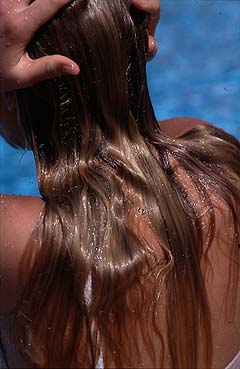
We were told just how deadly accurate the Contax G1 rangefinder is. We were shown diagrams which proved that the distance between the two windows in an AF rangefinder is of no consequence. The G1 was and is more accurate than any other comparable model. However, the proof of the pudding was available - shooting at f5.6, asking the models to move quickly, grabbing compositions on the 90mm. About 50 per cent of my shots were completely out of focus (nothing to do with AF accuracy, it just didn't work when used for grab-shots).
This visionary stuff and indoctrination about Contax G1 AF-rangefinding accuracy completed, we were free to shoot our German models and try out the Hologon, along with Agfa RSX100 film, so new that when I returned Joe's Basement sent back my cheque enclosed to pay for processing - my rolls were the first they had seen, and they were as keen as I was to have a look at the results.
My personal conclusion was that my own earlier comments on the G1 were largely justified. No-one can deny the lens quality or the overall build of the camera, but a G2 with better manual focus control would be welcome to make full use of the lenses. It seems that a 105mm, or perhaps a zoom, may be forthcoming for the G-system; we also know a 135mm with 'specs' is possible, and a 24 or 21mm of a similar design was not dismissed as fanciful.
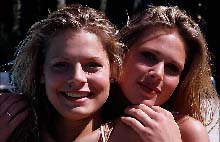

The G1 has its own very small flash but works with the bigger TTL units from the Contax SLR system. Fill-in synchro sun flash is not controllable, and the focal plane shutter syncs at 1/100th, but these two shots show that it works reasonably well - left, no flash, right, with flash. Both taken at f11.
My few hundred photographs taken there were the most varied and concentrated test I have given the camera. Successful shots were perfect, but failures were present on every roll and were usually unexpected. Nearly all the spoiled frames were shots on the 90mm lens taken at closer distances and wide apertures, of moving subjects or grabbed moments. In many of these cases, a second shot proved sharp where the first frame taken was simply not focused. Pictures taken with the 45mm and 28mm lenses were all sharp.
Attempts to use the camera for real action photography on auto-focus may be unfair, but that�s what many buyers expect it to tackle. The cover picture of this issue is one of three shots, each taken by asking the model to duck and then pull herself rapidly out of the water (see our cover photo). The G1 with 90mm was simply aimed and fired as she rose, a wide aperture of f5.6 ensuring an action-stopping 1/1,000th shutter speed. Two frames were focused on her shoulder. The selected shot for cover is still not perfectly focused (the strap is sharper than her eyelashes) but is acceptable. I am not entirely sure an AF SLR or a rangefinder camera would fare any better, but give me a manual focus RF camera and some planned guesswork, and I might just get closer to a perfect image.
Where the Contax G1 poses a problem is simple; it is not as perfect as we would want, but a Leica is no substitute as it does not focus as close (despite the latest lenses now focusing down to 60cm, most Leica M lenses don't go closer than 1 meter compared to the G1's 50cm), has no auto exposure and costs considerably more. Everyone agreed that a remake of the Minolta CLE would be attractive beside the G1, but this camera had one failing � focusing with the 90mm lens was so imprecise that it could rarely be used wider than f8. For 95 per cent of subjects (static ones), the Contax's AF with its faster 90mm was far superior to the accuracy of the CL/CLE and technically a match for a full sized Leica rangefinder.
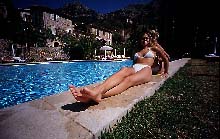

Left example is a Hologon shot at f8 with no center filter, and my own manually set exposure (with the sun out, no great problem). The right hand example shows the effect with the center filter at f16, almost essential, but very restricting.
I was cheeky enough to take my Russian 20mm f5.6 on an old Leica. The Hologon's sharpness was superior, of course, and its color rendering brighter, but the Russar pictures weren't very much inferior. The sharp, clear Hologon viewfinder had exactly the same visual field as the mediocre Russian 20mm finder. It shows a view equivalent to a 20mm, not the full 16mm angle. Was it too difficult to make a genuine 16mm finder?
Zeiss spoke about this lens as a dramatically new experience, but we�ve enjoyed affordable similar angled of view for two decades. My 1974 Soligor 17mm f4 had excellent geometry, sharpness and freedom from vignetting; a Pentax 15mm f3.5 I used a three years later was even better.
The Hologon will be a collectors' piece; as a working lens, I'll give it a pass. I saw some red faces as we viewed the awful results some editors had obtained by setting the exposure over-ride as emphatically suggested by our hosts. Maybe there was a translation problem, but they should really have known you don�t need 1/30 at f8 in bright sunshine.
Gone, entirely, is the deadpan neutrality of Agfa professional E6 color. RSX100 is an 'X' film in the Kodak 100X sense - hi-color, hi-contrast, enhanced sharpness, and warmth in outdoor light. I was knocked back by the skin tones; the cover shot on this issue is an example.
All the Agfa RSX100 shots, including a few finished on returning to Britain, had wonderful foliage greens, sky blues and skin colors. Everyone who saw the film fell in love with it, despite the punchy quality of Majorcan E6 processing. The Fujichrome Provia rolls processed alongside the Agfa provided a useful check; they were too 'hot' by far, while the Agfa was just OK.
Joe's Basement processing - the best in London - commented that RSX100 looked similar in color to Panther 100 but not as contrasty. Personally, I don't like over-the-top films such as Panther and Velvia; their extra saturation and density range can result in lost detail and gradation.
We shall be testing the entire 50, 100 and 200 speed range of new Agfa RSX emulsions technically (test targets, latitude, and grain) in the near future. (Shirley has taken my entire test stock to New York for a week, so maybe the technical stuff will have to wait). In the meantime, this film gets my approval as the first Agfa E6 which can hold its own on a lightbox next to a Fujichrome. This is not a criticism of earlier Agfa emulsions, by the way; their technical superiority, like that of Kodachrome, is not in dispute. It's simply that controlled contrast and low saturation lose out to 'hot' emulsions when what counts is instant impact. RSX100 seems a very fine compromise and a case of the West learning from the East to everyone's benefit.
- David Kilpatrick